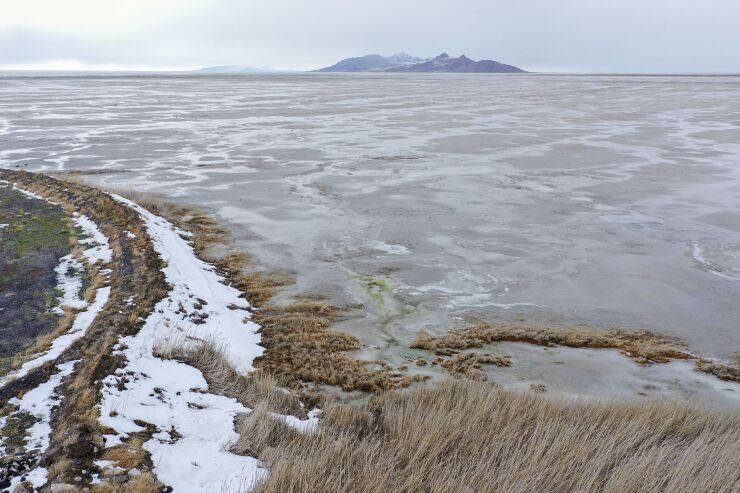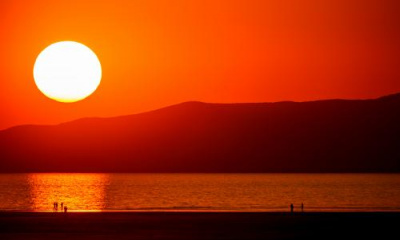A new bill unveiled Tuesday would establish unprecedented guidelines for how Utah should respond to its shrinking Great Salt Lake.
Lake Mead, Lake Powell and the Great Salt Lake all hit record lows over the summer and into the fall. But unlike the two reservoirs, Utah’s saltwater lake lacks a comprehensive framework for how water districts and the state can try to curb its decline.
Established in 2019, the Colorado River drought contingency plan dictates how much water states should cut from their allotment in response to levels at Nevada’s Lake Mead.
Instead of a mandate on water use, the Great Salt Lake drought contingency plan takes a market-based approach, imposing fees and allowing the Utah Division of Forestry, Fire and State Lands to buy or lease water rights from users in the Jordan, Weber and Bear river basins.
Zach Frankel, executive director of the Utah Rivers Council, said it would be hard to find support for a bill that mandates water cuts.
“This bill is meant to raise the price of water to embrace the free market,” Frankel told reporters Tuesday. “If you pulled up to the gas station and the price of gas was higher, then that might have an influence on how much gas you buy.”
What’s the plan?
The plan establishes four tiers based on a 10-year lake level average, when certain actions will be taken to promote water conservation.
According to the Utah Rivers Council, a healthy range for the lake is between 4,203 to 4,198 feet, and the current 10 year average is 4,194 feet. In October, when it dropped below a historic low set in 1963, the lake was measured at about 4,191 feet.
If the lake drops below 4,198 feet:
- The Division of Forestry, Fire and State Lands will seek voluntary water transfers, partnering with water conservancy and irrigation districts, canal companies, municipalities in the Jordan, Weber and Bear River basins “to voluntarily share water ... to meet the needs of people, industries, birds, and wildlife, and to sustain air quality by maintaining lake levels,” the bill reads.
- The division would also publish a report detailing how much water is needed to bring the 10-year average to healthy levels, and identify potential sources for the water.
If the lake drops below 4,194 feet:
- The division will buy or lease water rights from users in the three basins that feed the lake.
- State buildings within the three basins will stop watering “non-functional turf,” grass that needs water but has no recreational or environmental benefits.
If the lake drops below 4,192 feet:
- The division will impose a $75 fee for each acre-foot used by secondary water suppliers in the three basins. Agricultural water use is exempt.
- Institutional water users that are currently exempt from paying property taxes on water — schools, churches, parks and government facilities — will pay an additional $250 per acre-foot fee.
“The University of Utah uses 10% to 15% of all the water in Salt Lake City on an annual basis,” said Frankel. “But because they’re exempt, they don’t pay any property taxes whatsoever. Under this bill as it’s proposed now ... those kinds of entities would pay $250 per acre-foot upon their water use.”
If the lake drops below 4,190 feet:
- Secondary water suppliers will now pay a $150 fee per acre-foot, unless the same exemptions apply.
The bill states that revenue generated from the fees will go toward the Sovereign Lands Management Account. The Utah Rivers Council said the proposal could result in roughly $13 million from fees imposed on secondary water users.
Frankel also said Tuesday that the fees will fund acquisition of water rights for the lake.
The Utah Rivers Council wrote the bill, which is sponsored by Rep. Douglas Sagers, R-Tooele. It is still being refined and has not yet been numbered.
What is secondary water use?
Secondary water use refers to water that is not treated or potable and is typically used for irrigation. Most residents along the Wasatch Front would not be subjected to the fees imposed by the bill.
Nicholas Halberg, research and policy analyst for the Utah Rivers Council, said the Bear, Jordan and Weber river basins currently estimate about 183,000 acre-feet of annual secondary water use. That figure does not include agricultural water use, he said.
There are entities that use both treated and secondary water — but secondary water is usually delivered by a different system and billed separately, which Halberg says should prevent a fee being inadvertently levied on treated water.
Included in Utah Gov. Spencer Cox’s recently unveiled budget plan is $600,000 to update the Great Salt Lake management plan, $45 million in federal COVID-19 relief funds for conservation, and an additional $5 million that the legislature appropriated in May.
Cox also recommended $200 million for secondary watering metering, with an aim to help Utahns better track and conserve water usage.
“If Utah taxpayers are being asked to shell out $200 million for secondary meters, it’s very reasonable for us as taxpayers to ask for something in return. And what we want in turn is a healthy Great Salt Lake,” Frankel said.
Secondary water metering has proven to be a good way to reduce water use. According to a 2018 report from Western Resource Advocates, the Weber Basin Water Conservancy District saw between a 22% to 40% decrease in secondary water use “as a result of metering and communications with their customers.”
What Utah stands to lose as the Great Salt Lake declines
A recent summit hosted by Utah House Speaker Brad Wilson, R-Kaysville, aimed at saving the Great Salt Lake shows there is bipartisan support for water conservation measures. It also bodes well for the bill to have the support of a legislative leader, but it’s too early to tell whether the bill introduced Tuesday will gain traction in the Legislature.
“The short answer is, I don’t know,” said Frankel when asked about the proposal’s support, noting that the water users expected to pay higher fees under the bill will likely oppose it.
The lake is estimated to be a $1.3 billion economic boon. It sees 40% of the world’s brine shrimp harvest and provides the minerals for North America’s only supply of primary magnesium.
Sitting in the Pacific Flyway for millions of migratory birds, it’s also a temporary stop for at least 330 species that use the lake’s wetlands as a temporary home.
It’s a key factor in Utah’s $1.5 billion ski industry, which boasts the “best snow on Earth,” as storms rolling into the Wasatch are often bolstered by lake effect.
A shrinking lake also poses serious health risks. Dust exposed on the dry lakebed has concentrations of heavy metals, including arsenic, that can be kicked up by wind and dumped along the Wasatch Front. Exposure to the dust can lead to certain types of cancer and cardiovascular disease.









